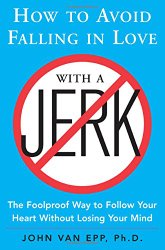
 How to Avoid Falling in Love with a Jerk
How to Avoid Falling in Love with a JerkThe Foolproof Way to Follow Your Heart Without Losing Your Mind
Reviewed July 16, 2014.
McGraw Hill, New York, 2007. 326 pages.
Original title: How to Avoid Marrying a Jerk.
Starred Review
2014 Sonderbooks Standout: #5 Nonfiction
Nine years after my husband left me, I've finally started dating again. And I'm finding it's not for the faint of heart! I'm also finding that I'm so starved for male affection, it's easy to let my feelings run away with me.
My sister is a Marriage and Family Counselor. For my 50th birthday, to celebrate that I've joined some online dating sites, she gave me a copy of this book, which she recommends to clients. Mind you, I haven't had a date since I read the book, but the ideas make a lot of sense to me, and I'm hoping to get chances to put them into practice.
His promise is that he can help you keep your head when following your heart. That would be nice, wouldn't it? The basic tool he teaches people to use is the Relationship Attachment Model. Here's where he describes it (with a helpful diagram):
The five fundamental dynamics are the depth to which you know, trust, rely on, have a commitment to, and have sexual involvement with another person....
Picture a sound system's equalizer with five up-and-down sliders evenly placed across the face of the board. The slider on the far left represents the extent to which you really know a person. As you move the bar on this slider up over time, you signify a richer, fuller, and more personal knowledge of the other. The next slider represents the range of trust you have for that person. This bar rises to denote a deeper, more positive, confident trust in your partner. The third slider represents the extent to which you rely on this person. Moving this bar up indicates the greater ways you depend on this person to meet your most significant needs. The fourth slider represents the range of commitment you have established with this person. The slider for this dynamic rises to signify greater levels of commitment expressed within your relationship. The final slider, on the far right, represents the degree of sexual touch and chemistry that exists between you and your partner. Elevating this slider signifies increases in the passionate chemistry and sexual contact with your partner....
Not only do these dynamics stand on their own as channels of bonding in your relationships, but they also interact with each other to produce a mix of the overall attachment in a relationship. As soon as you imagine some of the sliders up and some down, you immediately gain a sense of the mixed nature of love and attachment. In the same way that the controls on your equalizer affect the different tones of the overall sound of your music, the blend of the different levels of these five bonding relationship dynamics produces the "sound" of your attachment.
When all five are at the top level, the feelings of attachment are strongest. But when even one is low, attachment is weakened and your feelings of closeness become mixed. You are easily confused, hurt, and doubtful. The balance of all five bonding dynamics determines the healthiness of your relationship and the clarity of your perspective on your partner.
Here lies one of the most important keys to building a healthy relationship: keep a balance among the five relationship dynamics. Whenever the relationship dynamics shift out of balance with each other, you will feel unsafe, experiencing feelings of hurt, betrayal, confusion, mistrust, unfairness, anger, loneliness, or any combination of these. But when you keep these five dynamics in balance with each other so that you are not moving further ahead in one area than in any of the others, then you are securely planted in the safe zone.
There is one basic rule for guarding the safe zone: never go further in one bonding area than you have gone in the previous. This rule is based on the view that the five bonding dynamics have a specific order and logic to them: what you know about a person determines the degree you should trust him or her; this trust directs you in choosing what personal needs you can rely on him or her to meet; you should become committed only to the extent that you know, trust, and depend on that person; and finally, any degree of sexual involvement is safest when it matches the context of the overall intimacy reflected in the levels of the other four dynamics.
Slipping out of the safe zone explains the most common mistake people make in relationships: when the levels of the five dynamics are out of balance, then the emotional bond becomes unhealthy, and you tend to overlook crucial characteristics of the other person that should be exposed and explored. Thus, your love becomes truly blind. Or without knowing why, you wind up rationalizing characteristics and experiences that create a vague sense of unease.
This is by no means all that's in the book. In fact, there's almost too much detail. I felt like the author went on and on about what you need to know. But he continued with each of the relationship dynamics, explaining ways to strengthen that area, and providing plenty of examples and counterexamples. And the nice thing is that the big picture message is clear and easy to visualize.
And lest you think this model won't work or is impossible to carry out, the author refers to multiple studies that back up his views on how to build a healthy and happy relationship.
Definitely food for thought. I hope I will get to try it out!

